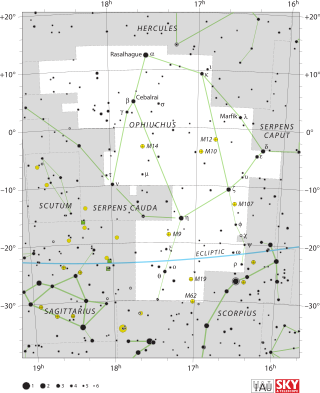Top Qs
Timeline
Chat
Perspective
Theta Ophiuchi
Star in the constellation Ophiuchus From Wikipedia, the free encyclopedia
Remove ads
Theta Ophiuchi, Latinized from θ Ophiuchi, is a multiple star system in the equatorial constellation of Ophiuchus. It lies on the "right foot" of the serpent-bearer, just southwest of Kepler's Star, the nova of 1604. According to Richard H. Allen's Star Names: Their Lore and Meaning (1899), θ Oph together with ξ Oph formed the Sogdian Wajrik "the Magician", the Khorasmian Markhashik "the Serpent-bitten" and with η Oph the Coptic Tshiō, "the Snake", and Aggia, "the Magician".[12] This star has an apparent visual magnitude of +3.3,[6] making it readily visible to the naked eye. Based upon parallax measurements from the Hipparcos mission, it is roughly 436 light-years (134 parsecs) from Earth.[1] It is 1.8 degrees south of the ecliptic and therefore subject to lunar occultations and (very rarely) occulted by a planet. The next occultation by a planet will be by Mars on 3 October 2078.[13]
Remove ads
Theta Ophiuchi appears to be a triple star system. The brightest component is a spectroscopic binary with an orbital period of 56.71 days and an eccentricity of 0.17. The third component is 5.5 magnitude star with a stellar classification of B5. Its angular separation from the binary pair is 0.15 arcseconds.[14] This system is a proper motion member of the Upper Scorpius sub-group in the Scorpius–Centaurus OB association, the nearest such co-moving association of massive stars to the Sun.[6]

The primary component of this system is a variable star of the Beta Cephei type with a period of just 3h 22m.[16] It has nearly nine[3] times the mass of the Sun and more than six[7] times the Sun's radius. Although only 21 million years old,[3] it has begun to evolve away from the main sequence and has become a subgiant star with a stellar classification of B2 IV.[3] This massive star is radiating around 5,000 times the luminosity of the Sun from its outer atmosphere at an effective temperature of about 22,260 K,[8] giving it the blue-white hue of a B-type star.[17]
Remove ads
References
Wikiwand - on
Seamless Wikipedia browsing. On steroids.
Remove ads

